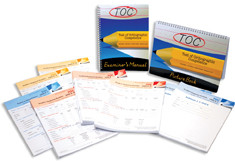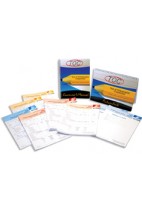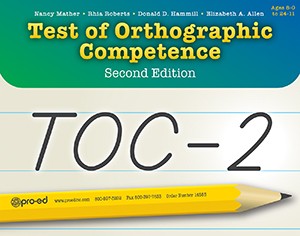*DISCONTINUED (*NEW EDITION in Alternatives below)
Contents
-

Test of Orthographic Competence (TOC)
TOC Examiner Record Forms (Ages 6-7) (25)
$39.00 -

Test of Orthographic Competence (TOC)
TOC Student Response Booklets (Ages 6-7) (25)
$67.00 -

Test of Orthographic Competence (TOC)
TOC Student Response Booklets (Ages 8-12) (25)
$75.00 -

Test of Orthographic Competence (TOC)
TOC Student Response Booklets (Ages 13-17) (25)
$75.00
- Signs and Symbols. The child looks at a series of printed signs and symbols such as a “club” from a deck of cards, an “equal” or a “dollar” sign, or a numeral “5.” The child is asked to tell the examiner what each sign signifies.
- Grapheme Matching. The child is shown a series of rows each of which has five figures. The figures can be objects, signs, letters, or group of letters (e.g., b e o l e). In each row, two of the five figures are identical. The child is to identify the two identical figures in each row by making a slash through them. The child is given two minutes to complete as many rows as possible.
- Homophone Choice. Students look at a picture with two or three possible spellings choices (e.g., a picture of a boat oar with the spelling choices of oar, ore, and or). The students then circle the word they think is the correct spelling for the picture in each row.
- Punctuation. The student is given a list of printed sentences that contain no punctuation except for spacing between the words (e.g., where is edward b brown). The task is for the student to supply the missing punctuation by editing the sentence.
- Abbreviations. The examiner points to one of several abbreviations printed on a page (e.g., 4:00, Dr., USA) and asks the student to tell or write (depending on which version is given) what the particular abbreviation means.
- Letter Choice. The student is shown rows of words where one of four letters (p, d, b, or q) is missing from the word (e.g., _etter where the letter b is missing from the word or sai_ where the letter d is missing from the word). The student is given two minutes to write in the correct letters that will make each one into a real word.
- Word Scramble. The student is shown sets of scrambled letters that can be rearranged to spell real words (e.g., the letters nra can be rearranged to spell the word ran). The student has three minutes to re-order as many groups of letters into words as possible within the time frame.
- Sight Spelling. The examiner says a word and the student is shown part of the word where one or more of the letters is missing (e.g., the examiner says the word know and student sees ___ow.) The student is asked to fill in the missing letter or letters to complete the spelling of the word.
- Word Choice. The examiner says a word and the student looks at three possible phonically regular spellings choices (e.g., sitty, sitee, city). The student then circles what he or she thinks is the correct spelling of the word in each row.
-

Test of Orthographic Competence (TOC)
TOC Examiner Record Forms (Ages 6-7) (25)
$39.00 -

Test of Orthographic Competence (TOC)
TOC Student Response Booklets (Ages 6-7) (25)
$67.00 -

Test of Orthographic Competence (TOC)
TOC Student Response Booklets (Ages 8-12) (25)
$75.00 -

Test of Orthographic Competence (TOC)
TOC Student Response Booklets (Ages 13-17) (25)
$75.00
- Copyright 2008

 Proud to be Canadian
Proud to be Canadian


